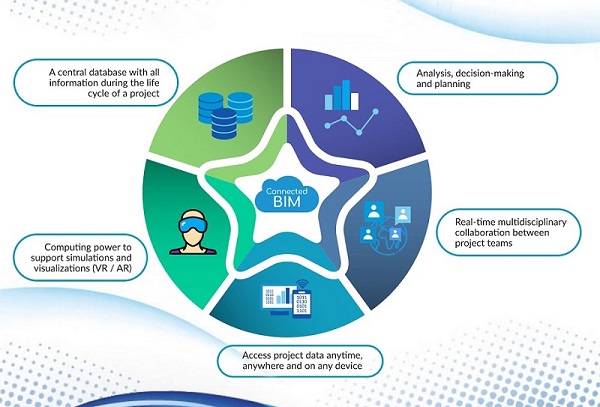Technical Area | Articles
The place to solve all your BIM doubts
What is Connected BIM and how it will shape the AEC industry
BIM Implementation Infrastructures
Among all practices adopted by architecture, engineering, and construction (AEC) firms, BIM modeling is the most powerful. It can help firms in this sector improve the quality of deliverable while controlling and minimizing costs. BIM is going through a sort of transformation at the moment.
Powered by cutting-edge technologies, BIM modeling became connected BIM. It is bound to change forever the collaboration between architects, engineers, and contractors and help firms in the AEC sector increase ROI. Here is everything you need to know about connected BIM and how it will affect the AEC industry.
What is BIM? A Quick Reminder
BIM stands for Building Information Modeling. It encompasses hundreds of processes to help professionals in architecture, engineering, and construction firms get the job done accurately within a specified time window.
BIM is a 3D model-based process. It is also often referred to as a creative process because it delivers crucial data for project planning, execution, and completion. Every object in the BIM model contains data, and changing one purpose triggers the automatic update, which changes the entire model.
It also incorporates workflows for the entire project; this includes managers, teams, and individuals in the whole AEC sector. What more could we ask for, right? Connected BIM takes BIM as we know it, enhances it, and unlocks its real power. Let’s see how.
Improved Accessibility
Connected BIM has the potential to shape AEC in terms of project accessibility as well. Imagine if anyone on the entire team could access the project and review the requirements in real-time. Imagine being able to notify everyone on board when a project-changing update has been made. The connected BIM project remains the centerpiece of the construction project.
Staying up to date with the project data and new updates will no longer be an issue the teams on the ground have been struggling with the most. This is great news for joint venture projects. With connected BIM, teams will be able to get hold of relevant information and work together as one whether they are in the same or in two separate locations.
AEC Industry Digitization
If we had to point out only one strong point of connected BIM, then it would be its capacity to digitize the entire AEC industry. This was not something that could be done before because we lacked the technologies. Today we have the cloud, RFID chips, sensors, IoT solutions, mobile devices, and intelligent machines.
What does this mean? Every process in the AEC sector can be digitized. When you can digitize design, fabrication, and construction processes, you open the new door to productivity, cost-efficiency, and streamlined project completion. All of it can be done through one solution - a BIM-connected cloud platform.
Digitization of the AEC industry and all the processes it encompasses is a long term effort. This process has already started. But with new technologies and connected BIM, it can finally take its pure form. Considering all the benefits it brings to the table, it is safe to assume to see its high adoption rates throughout the AEC industry.
Get Control Over Every Project Life cycle
Projects in the AEC industry have several project life-cycles. Each one of these cycles is crucial for successful project completion. If you want to move from one life-cycle to another, the previous one has to be completed with extreme accuracy, and the materials, workforce, and processes of the next one have to be ready. To do this, teams need access to up-to-date data. This is where connected BIM comes to shape the industry.
While BIM leverages connectivity to collect the data and deliver it to teams when it is needed, the data about project life-cycles can be used in different ways. For instance, all the operational data can be used for further project improvements. This doesn’t only apply for the current, but future projects as well.
Even when the project is over, the data can be used for building maintenance and future renovations and upgrades. The AEC industry finally has a solution that can help firms make informed decisions for every project life-cycle.
Removes Collaboration Barriers
BIM modeling powered by connectivity technologies can serve as a central communication hub for everyone involved in a project. Keeping communication lines open between designers, architects, and contractors is very hard. It requires a lot of planning ahead and time. Thanks to connectivity tech, BIM can now remove collaboration barriers and boost productivity.
All the information is inside the 3D model. The information flow is not disrupted, as everyone with proper user privileges can make changes. When you can see the latest updates and how they reflect your workflow, it becomes easy to adjust and get the job done.
Connected BIM is a new thing, and we are yet to see all the benefits BIM services have to offer to architects, engineers, and construction firms. These are its strongest points, and each one on its own has the capacity to shape the AEC industry.
With no collaboration barriers, improved access to data, and accurate digitization of processes, the AEC industry will take a new form where productivity and cost-efficiency will be easy to control and improve.












